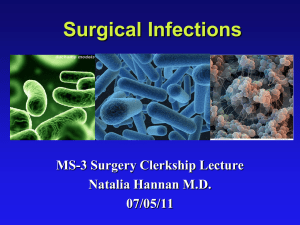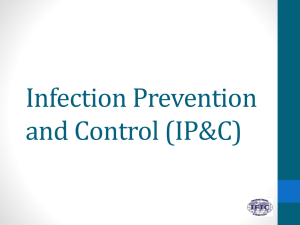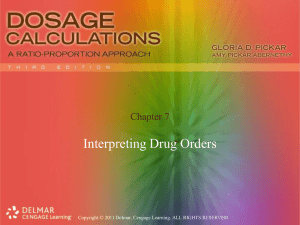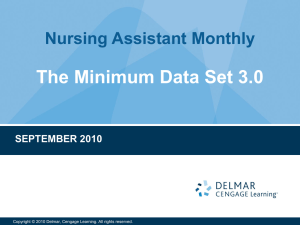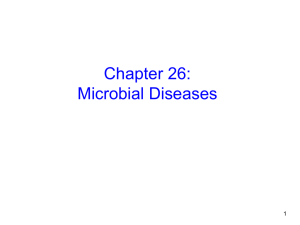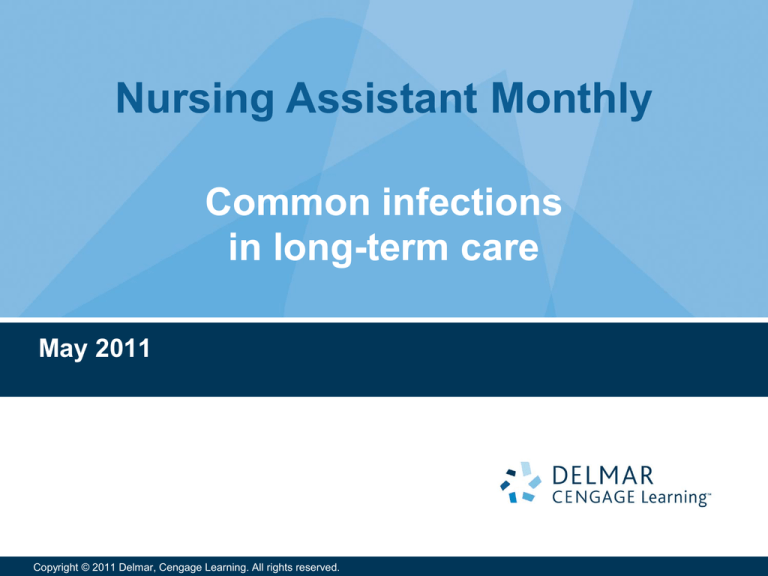
Nursing Assistant Monthly
Common infections
in long-term care
May 2011
Copyright © 2011 Delmar, Cengage Learning. All rights reserved.
Why be concerned?
A combination of factors make infection…
More likely
– Older adults with chronic health problems may have weaker immune
systems.
– Closer quarters in community living help infections spread.
– Cognitively impaired residents may not always follow hygiene
measures.
More severe
– Residents who transfer from the hospital can bring new, drugresistant germs that are difficult to treat.
May 2011
Copyright © 2011 Delmar, Cengage Learning. All rights reserved.
Common infections in LTC
Infection types
Urinary tract
The most common kind of infection in nursing homes
– Lower urinary tract most common (bladder) but can travel up to
kidneys
– Can spread to body in a massive infection called sepsis
What can you do?
– Encourage fluids to keep urine clear
– Provide good perineal hygiene, also catheter care
– Good handwashing for both you and the resident after toileting
May 2011
Copyright © 2011 Delmar, Cengage Learning. All rights reserved.
Common infections in LTC
Repiratory infection
Upper tract
Nose, sinuses, throat
Lower tract
Bronchial airways and lungs
Most respiratory infections are spread through the air or by
droplets that land on surfaces.
That is why washing hands and disinfecting surfaces
frequently is so important!
May 2011
Copyright © 2011 Delmar, Cengage Learning. All rights reserved.
Common infections in LTC
GI (gastrointestinal) infection
Spread through the orofecal route
– This means the organism finds its way from the stool of an infected
person to the mouth (of the same or another person).
Most common way this happens?
– Lack of proper hand washing
Prevention
– Hand hygiene of caregiver and resident
– Contact precautions if GI infection is present
May 2011
Copyright © 2011 Delmar, Cengage Learning. All rights reserved.
Common infections in LTC
Skin infections
Scabies is very common
– Caused by a tiny mite, invisible to the naked eye
– Red lines on skin may be visible where the mites burrow
– Intense itching, especially at night
Prevention
– Scabies is very contagious
– Treatable but source must be found and treated
– Source may be a family member, or staff member
May 2011
Copyright © 2011 Delmar, Cengage Learning. All rights reserved.
Common infections in LTC
Precautions- 2 basic types
Standard
– Used for ALL caregiving
– Hand hygiene
– Gloves when touching body fluids (except sweat)
– Gown and eye protection if risk of body fluids splashing
Transmission-based
– Additional measures to prevent transmission of a known infection
– Contact, Droplet, Airborne depending on how the infection spreads
May 2011
Copyright © 2011 Delmar, Cengage Learning. All rights reserved.
Common infections in LTC
Some final thoughts
New drug resistant organisms- a growing problem
– A main cause is overuse of antibiotics
– Germs learn to survive even when antibiotics are used
What can you do?
– Encourage residents to drink enough fluids
– Keeps urine clear
– Cloudy urine may be due to lack of enough fluid intake, and
might be treated as an infection unnecessarily
May 2011
Copyright © 2011 Delmar, Cengage Learning. All rights reserved.
Common infections in LTC




